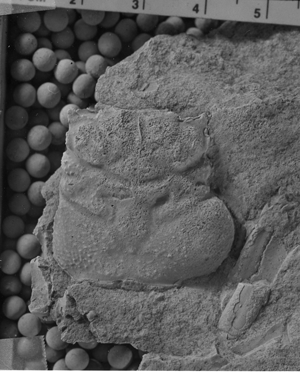
Tumidocarcinus giganteusMany fossil crabs show evidence of having been parasitized during life. The crab at left is a parasitically-castrated male. The abdomen is broad, mimicking that of a female. The parasite was a rhizocephalan barnacle that uses the host's reproductive organs as food, castrating the animal. The barnacle produces a sac-like structure from which it reproduces; this sac rests upon the male's abdomen.Photo by R. Feldmann |
|
 |
Torynomma sp.This crab is infested with a bopyrid isopod, which lives in the gill chambers of the crab. The asymmetrical swelling on the right side of the carapace is evidence of the isopod's presence.Photo by R. Feldmann |
back to top